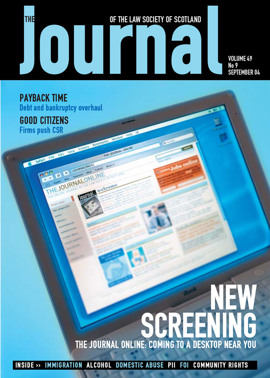Beware all conveyancers!
Following the Keeper’s article regarding the Register of Community Interests (July Journal, page 58), a word of warning to conveyancers.
Contrary to popular belief, the community right to buy under the Land Reform (Scotland) Act 2003 does not just affect the countryside, but has much wider application – ALL conveyancers should take note.
Briefly, communities (persons resident and entitled to vote in a postcode unit or postcode units: section 34(5)) have right, through companies limited by guarantee, to register their interest in “land” which is not excluded from the scope of the Act, in which a “significant number” of the community has a “substantial connection”, or is “sufficiently near to” that land (section 38(1)). None of these expressions is defined.
Once a community interest is registered a would-be seller is prohibited, except in a limited number of instances, from transferring the land (or larger subjects of which it forms part), or from “taking any action with a view to its transfer” (i.e. advertising it or entering into negotiations with another party: section 40(5)), without first offering it to the community.
The community may then purchase the land, with the approval of ministers (and thus prevent an open market sale), at a price fixed by a government-appointed valuer, provided that it can demonstrate sufficient local support, through a ballot, and that the right is to be exercised in the “public interest” and for the purpose of “sustainable development” (section 51(3)). Again neither expression is defined. A community interest may also, in exceptional circumstances, be registered after the seller has started the sale process, at any time until missives or the grant of an option have been concluded (section 39).
The scope of the right to buy is wide.
- It applies to a sale by the owner of the land or by a heritable creditor exercising power of sale under a standard security (section 47(1)).
- It applies to all land in Scotland, and accordingly in the crofting counties runs concurrently with the crofting community right to buy (which is not covered here).
- “Land”, given its traditional meaning in Scots law, includes buildings. Accordingly, dwellinghouses, all forms of commercial, licensed and unlicensed premises will, together with bare land and what we would traditionally recognise as rural land and buildings, be included within the right, as are salmon fishings and mineral rights.
- Most importantly, under the Community Right to Buy (Definition of Excluded Land) Scotland Order 2004, only those settlements where the population is over 10,000 are excluded land. The main cities are, of course, excluded but only some 50 other towns are excluded. Most towns and villages in Scotland are covered by the right, including many that one might not immediately think of as rural!
Acting for a purchaser, you will need to require the seller to warrant that he has not received intimation of an application for registration, a notice prohibiting a transfer, a registered interest and/or an application for late registration and that he has not taken any action with a view to transfer.
You should, I believe, also demand that the seller exhibits clear searches in the Register of Community Interests in response to your offer to purchase, immediately prior to conclusion of missives and, again, immediately prior to settlement.
This is far-reaching legislation having, potentially, a considerable impact on the sale of property, not just by country squires but also by businesses and lending institutions/funders with property situated in towns and villages. The effect of a land transfer in defiance or ignorance of a registered community interest is that the community can, for a period of 10 years, activate its right to buy against the purchaser, who is bound to submit to the right. In effect, therefore, the purchaser of non-excluded land may, in certain circumstances, receive only a prescriptive title.
The extra responsibility which the Act has placed on conveyancers is, unfortunately, a sledgehammer to crack what may be a very small nut (instances where the community right to buy is exercised), but that responsibility cannot be ignored by any conveyancer in case the “bad apple” is missed.
Alasdair Fox,Anderson Strathern
In this issue
- Profession's voice must be heard
- Let the cameras speak
- Vision on
- Forgive us our debts
- Written down
- DAS: the broader picture
- A lost message
- For the greater good
- Start your engines
- Are you covered?
- Opportunity knocks
- Rock bottom?
- BAILII looks for help
- On level ground
- Taking freedom seriously
- Taking out abuse
- Be ready for the options hearing
- Now it's collaborative
- Winning around a table
- Website reviews
- Scottish Solicitors' Discipline Tribunal
- Book reviews
- Beware all conveyancers!
- A-day looms closer






